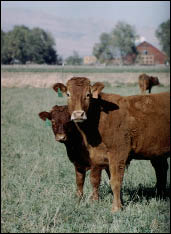

It's a cattlemen's dream. In one cow, you've got a high lean red meat to bone ratio, a high feed converter, heavy muscling and carcass traits, calving ease, more than enough milk, and a good disposition. What else could you want? Genetics that are improving constantly and shorter gestations? Done. Welcome to the world of Limosin cattle.
Long been one of the kings in the cattle states of the Mid-West, Limosins have been a challenge in the Northwest. Though virtually perfect for commercial crosses, they have been over looked. According to Joe Hattrup, a purebred Limo breeder in Wapato, Wash., it's tough for everybody not raising Angus or Hereford.
Hattrup first discovered the kings of kings during the mid-80s when he bought a purebred bull from a retiring breeder. He liked the bull so much, he bought the rest of the retiree's herd. "I started the purebred herd in 1986," said Hattrup, "and I've been impressed with the bulls, and cattle in particular."
He now has 125 purebred cows and heifers and a commercial herd of 150 Angus-Limosin cross. Both herds were built at about the same time because his focus has been to build sound, functional bulls for the commercial market.
"I've worked hard on herd improvement with embryo transfer and artificial insemination for years," he said. Having took an AI class in 1989, he has AI'd extensively, though not exclusively, ever since. And he semen tests everything that hits the ground.
His three top bulls are a red full-blood and two homozygous black polleds. "The problem with the breed is the focus on blacks," said Hattrup. "But that's the nature of public opinion right now. When equal or better, a red consistently undersells the blacks."
However, Hattrup feels the upside to the trend is the mixing of red and black sires creates better cattle.
The commercial herd was built off of AI, retaining heifers for the herd by Angus sires. His trick is good, sound genetics. Each year, he AI's all of his commercial females to two or three Angus bulls and then AI's all of his purebred females to selected Limo bulls. By keeping a set and selling a set, he keeps his genetics are strong. His replacement Angus/Limo heifers are all AI'd to high quality Angus bulls to ensure calving ease.
His commercial and purebred herds have to gestate together and he says they perform the task, partially due to the breed. AI'd heifers calve at 22 to 24 months. A spring calving operation, the embryo transfers and first calf heifers usually calve from January to mid-February while his AI and standard breeding cows calve from February 1 to April 1.
Of course there is a lot of work to maintaining a purebred herd because of the additional paperwork like records, weaning weights, and trends in the breed but Hattrup feels he has a lot more interaction with his herd as a result. "I enjoy assessing the cattle from the matings to the sale. But you just don't do it if you don't enjoy cattle," he said.
"It's not at all like having cows for a couple of years and then selling them. At the sales, it becomes a people business. I like going to ranches to see cattle out of my bulls. Then they come back and want more, which is really rewarding," he said. "At first you feel like an unknown, not knowing if anyone will buy your cattle, but if you have a good, solid animal, you will be supported by the prices."
He feels the breed offers a lot of extra length in the muscle and body. "Regular carcasses usually get 62 to 63 percent," said Hattrup, "but ours consistently get 64 to 65 percent, or more." His carcasses are also rating from low choice to high select.
Recently active on the state board for the Washington State Limo Association, Hattrup focuses on having an overall active role. The state association had a coastal focus because there were few breeders on the eastern side of the state. Through his active role in the association as well as managing the state bull test sale for five years and the Central Washington Limosin sale for nine years, he has been instrumental in shifting the association to a more central location. Currently, the state sale is held in Ellensburg as a result. A percentage of his cattle are sold at local and state sales in Washington and Oregon while most of his bulls are sold via private treaty.

His dad started him in cattle with the family ranch. The ranch was started out of sage brush in the 50s and was diversified between cattle, tree fruit and feed. His father sold off his cow-calf herd in the early 70s and Joe kept and pastured for a few years before he started his current herds. In addition to cattle, he also raises apples, pears, cherries and wine grapes and is active in tree fruit organizations as well as with WSU research. Raising most of his feed, he puts up his own hay and silage along with occasional corn so he only has to buy barley and oats. His wife, Susan, of 17 years supports him in his endeavors though she prefers to spend her time in the horse world.
"Offer good cattle and stand behind them," said Hattrup, "You may suffer the ups and downs in the market, but if you're cattle is solid, you'll earn a good reputation."